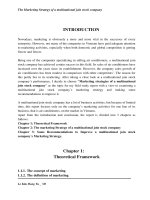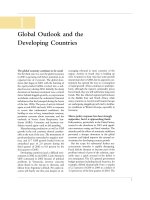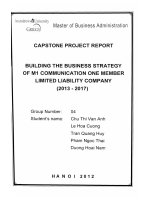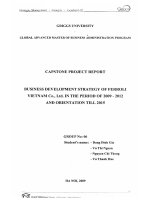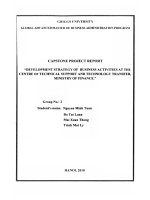The development strategy of power company no.2 up to 2015 and orientation to 2020
Bạn đang xem bản rút gọn của tài liệu. Xem và tải ngay bản đầy đủ của tài liệu tại đây (3.65 MB, 154 trang )
GRIGGS UNIVERSITY
GLOBAL ADVANCED MASTER OF BUSINESS ADMINISTRATION PROGRAM
CAPSTONE PROJECT REPORT
THE DEVELOPMENT STRATEGY OF
POWER COMPANY No.2 UP TO 2015
AND ORIENTATION TO 2020
Group No: 2
Student’s name:
NGUYEN THANH DUY
TRAN HUU MINH
NGUYEN ĐAC THANG
THAI PHONG LINH
Class: GeMBA01.E04
HO CHI MINH CITY – 2010
ii
ACKNOWLEDGEMENTS
We would like to assure that this Capstone Project
Report is the study of our own group. Contents and results
of research in the capstone project report are honest and
they have never been published by scientific projects of
other authors.
AUTHORS
NGUYEN THANH DUY
TRAN HUU MINH
NGUYEN DAC THANG
THAI PHONG LINH
==========================================
iii
TABLE OF CONTENTS
Template cover i
Acknowledgements ii
Table of contents iii
List of symbols, abbreviations vii
List of appendices viii
List of figures, graphs ix
List of tables xi
Preface 1
INTRODUCTION 2
1. General context, the necessity and significance of topics 2
2. The research objectives 4
3. The research methodology 5
4. Structures 6
CHAPTER I: THEORY AND KNOWLEDGE REVIEW
STRATEGIC MANAGEMENT PROCESS OVERVIEW 7
1.1. Strategic management 7
1.1.1. Concepts 7
1.1.2. Requirements of planning and implementing strategies 8
1.1.3. The role of strategic management 9
1.1.4. Stages of strategic management 10
1.1.5. Levels of strategic management 11
1.1.6. Mission and objectives definition 11
1.2. The research methodology and strategic tools 16
1.2.1. Macro and micro environment analysis 17
1.2.1.1. Macro Environment 17
1.2.1.2. Micro Environment 20
1.2.2. Internal Environment analysis 23
1.2.2.1. Value chain analysis 23
iv
1.2.2.2. Analyzing factors out of value chain 24
1.2.3. The strategic tools 26
1.2.3.1. External Factor Evaluation Matrix – (EFE Matrix) 26
1.2.3.2. Internal Factor Evaluation matrix – (IFE Matrix) 27
1.2.3.3. Internal- External Matrix (IE Matrix) 28
1.2.3.4. SWOTT Matrix combined for planning strategies 29
1.2.3.5. The Quantitative Strategic Planning Matrix (QSPM) 30
CHAPTER II: PC2’S CURRENT SITUATION ANALYSIS-
THE EXTERNAL AND INTERNAL ENVIRONMENTAL
ANALYSIS - SWOT MATRIX ANALYSIS 34
2.1. Overall introduction of EVN 34
2.1.1. Functions and responsibilities 34
2.1.2. Structure of EVN’s Organization 34
2.1.3. Relationship between EVN with Power Companies 35
2.2. Introduction of Power Company No 2 38
2.2.1. History of formation and development 38
2.2.1.1. History of formation 38
2.2.1.2. History of development 39
2.2.2. Functions and responsibilities 39
2.2.2.1. Functions 39
2.2.2.2. Responsibilities 40
2.2.3. Organization Structure 41
2.2.3.1. PC2’s organization Chart 41
2.2.3.2. Production technology process 44
2.2.4. Analyzing the results of PC2’s production and business
operations in latest years 45
2.2.4.1. Analyzing PC2’s scale and present condition 45
2.2.4.2. Analyzing the results of PC2’s production and core business
operations in latest years 46
v
2.2.4.3. Analyzing Public Telecom services- non-core business line 49
2.2.4.4. Comparing some key factors between PC2 and PC1, PC3 53
2.3. External and Internal environmental analysis 53
2.3.1. External environment analysis 53
2.3.1.1. Macro Environment 53
2.3.1.2. Micro Environment 58
2.3.2. Internal Environmental analysis 61
2.3.2.1. Value chain analysis 61
2.3.2.2. Analyzing factors out of the value chain 75
2.4. EFE Matrix- IFE Matrix- IE Matrix 80
2.4.1. EFE Matrix 80
2.4.1.1. Opportunities 80
2.4.1.2. Threats 81
2.4.1.2. EFE Matrix 82
2.4.2. IFE Matrix 78
2.4.2.1. Strengths 78
2.4.2.2. Weaknesses 78
2.4.2.2. IFE Matrix 79
2.4.3. Internal- External Matrix ( IE Matrix ) 83
CHAPTER III: BUILDING THE STRATEGIES AND SOLUTIONS
FOR PC2 - RECOMMENDATIONS AND CONCLUSIONS 86
3.1. Orientation of Vietnam government about the development of
electricity sector to 2020, vision to 2050. 86
3.2. The development strategy of EVN 86
3.3. The Electric Planning VI of Government 88
3.4. Forecasting and some point of views on restructuring of EVN 89
3.4.1. Forecasting work in the period 2010- 2015 and orientation to 2020 89
3.4.1.1. Forecasting sales electricity 89
3.4.1.2. Forecasting revenue and average selling price 92
vi
3.4.1.3. Forecasting electricity losses 94
3.4.1.4. Limitations of the forecast methods using statistical tools 96
3.4.2. Some point of views on restructuring of EVN 97
3.5. Vision, mission, objectives and strategic plans 103
3.5.1. Vision 103
3.5.2. Mission 104
3.5.3. Objectives 105
3.5.4. SWOT matrix combined to formulate strategies 106
3.5.5. The strategic alternatives 108
3.6. Selection of strategies for PC2 109
3.6.1. QSPM Matrix 109
3.6.2. The corporate level strategies 117
3.6.3. The functional level strategies 117
3.7. Solutions to implement the strategies 117
3.7.1. Solutions to implement the corporate level strategies 117
3.7.2. Solutions to implement the functional level strategies 120
3.7.3. Planning implement and investment capacity the strategies of PC2 128
RECOMMENDATIONS AND CONCLUSIONS 130
1. Recommadations 130
2. Conclusions 130
REFERENCES and APPENDICES 133
===========================================================
vii
LIST OF SYMBOLS, ABBREVIATIONS
- ADB: Asian Development Bank
- AFD: Agence Française de Développement
- APEC: Ascia-Pacific Economic Cooperation
- ATM: Automated Teller Machine (cash machine)
- ASEAN: The Association of Southeast Asian Nations
- CMIS: Customer Management Information System
- IT: Information and Technology
- EVN: Electricity of Vietnam
- FDI: Foreign Direct Investment
- FMIS: Financial Management Information System
- GDP: Gross Domestic Product
- GENCO: Generation Company
- GNP: Gross National Product
- JBIC: Japan Bank for International Cooperation
- JICA Japan International Cooperation Agency
- LAN: Local Area Network
- ODA: Official Development Assistance
- PC2: Power Company number 2
- ROA: Return on Assets
- ROE: Return on Equity
- SADA: Supervisory Control and Data Acquisition
- SMS: Short Message Service
- SRPC: South Regional Power Company
- SWOT: Strengths- Weaknesses- Opportunities- Threats
- VND: Vietnam Dong (Vietnamese currency)
- WAN: Wide Area Network
- WB: The World Bank
- WTO: The World Trade Organization
viii
LIST OF APPENDICES
Appendix list Appendix’s Name Page
Appendix 01: Calculation of PC2’s financial ratios in
2006-2007-2008 135
Appendix 02: Capital contribution of PC2 to the join stock 137
Corporations
Appendix 03: Electricity supply situation of PC2’s provinces/city 138
in 2008
Appendix 04: Vote for the expert’s opinions 139
===========================================================
ix
LIST OF FIGURES AND GRAPHS
Figures list Figure’s name Page
Figure 1.1 SWOT general model 16
Figure 1.2 Model 5 competitive pressures 20
Figure 1.3 The structure of IE matrix 28
Figure 1.4 Model SWOT Matrix combined to formulate strategy 30
Figure 2.1 Map of EVN’s geographical management 34
Figure 2.2 Organizational chart of EVN 37
Figure 2.3 Head office of Power Company No.2 38
Figure 2.4 Map of PC2’s geographical management 39
Figure 2.5 Organizational chart of PC2 44
Figure 2.6 Line Chart of the distribution grid growth of PC2
in the period 2000-2009 63
Figure 2.7 Line Chart of the 110kV grid growth of PC2
in the period 2000-2009 63
Figure 2.8 Line Chart of the 110kV grid fault performance 64
Figure 2.9 Line Chart of the distribution grid fault performance 64
Figure 2.10 Pie Chart of the labor structure of PC2 in 2009 66
Figure 2.11 PC2’s monthly meeting via video conferencing system 68
Figure 2.12 Column chart of PC2’s Customers in the
period 2000-2009 69
Figure 2.13 Column Chart of PC2’s sales electricity
in the period 2000-2009 71
Figure 2.14 Pie Chart of PC2’s Sales Electricity in 2009 72
Figure 2.15 Column Chart of PC2’s Sales Electricity
in the period 2000- 2009 73
Figure 2.16 Line Chart of PC2’s electricity losses
in the period 2000-2009 74
Figure 2.17 IE Matrix of PC2 85
x
Figure 3.1 Line Chart of the sales electricity of PC2 in the period
1998-2009 and trend equation on chart 90
Figure 3.2 Chart of PC2’s sales electricity forecast
in the period 2010-2020 90
Figure 3.3 Line Chart of the revenue of PC2 in the period
2000-2008 and trend equation on chart 92
Figure 3.4 Chart of PC2’s revenue forecast
in the period 2010- 2020 93
Figure 3.5 Line Chart of PC2’s electricity losses in the period
2000-2009 and trend equation on chart 95
Figure 3.6 Chart of the electricity losses forecast of PC2
in the period 2010-2020 95
Figure 3.7 SWOT Matrix combined to building strategies 107
==========================================================
xi
LIST OF TABLES
Table list Table’s name Page
Table 1.1 Structure of QSPM Matrix 31
Table 2.1 PC2’s production and business activities
in the period 2006-2009 47
Table 2.2 PC2’s power network in the period 2006-2008 47
Table 2.3 PC2’s volume and construction investment capital
in the period 2006-2008 48
Table 2.4 Some targets on manufacturing and trading
in the period 2006-2008 49
Table 2.5 PC2’s Telecom service business activities
in the period 2006-2009 49
Table 2.6 Some differences between PC2 and PC1, PC3 53
Table 2.7 Macro economic data of Vietnam
in the period 2004-2009 54
Table 2.8 PC2’s quantity of power lines and substations
in the period 2000-2009 62
Table 2.9 PC2’s power grid fault performance 64
Table 2.10 Labor structure on level in 2009 65
Table 2.11 Layout employees of PC2 in the period 2004-2008 66
Table 2.12 Comparison of labor productivity between PC2
with other country's electricity sector 67
Table 2.13 Customers of PC2 in the period 2000-2009 69
Table 2.14 Electric production of PC2 in the period 2000-2009 70
Table 2.15 Sales electricity of PC2 in the period 2000-2009 71
Table 2.16 Sales electricity ratio of PC2 in the period 2000-2009 72
Table 2.17 Electricity losses of PC2 in the period 2000-2009 74
Table 2.18 Balance sheet of PC2 in 2006-2007-2008 76
Table 2.19 Report of PC2’s business results in
xii
2006- 2007- 2008 76
Table 2.20: Financial analysis of PC2 in 2006-2007-2008 77
Table 2.21: EFE Matrix of PC2 82
Table 2.22: IFE Matrix of PC2 84
Table 3.1 Sales electricity of PC2 in the period 1998-2009 89
Table 3.2 Forecasting sales electricity of PC2 in the period
2010-2020 91
Table 3.3 The revenue and average selling price of PC2
in the period 2000-2009 92
Table 3.4 Forecasting the revenue and average selling price
of PC2 in the period 2010-2020 94
Table 3.5 Electricity losses of PC2 in the period 2000-2009 94
Table 3.6 Forecasting electricity losses of PC2 in the period
2010-2020 96
Table 3.7 QSPM Matrix combined strategy S-O 109
Table 3.8 QSPM Matrix combined Strategy S-O continue 110
Table 3.9 QSPM Matrix combined Strategy W-O 111
Table 3.10 QSPM Matrix combined Strategy W-O continue 113
Table 3.11 QSPM Matrix combined Strategy S-T 114
Table 3.12 QSPM Matrix combined Strategy W-T 115
Table 3.12 QSPM Matrix combined Strategy W-T continue 116
Table 3.13 Planning investment capacity to implement
the strategies in the period 2010-2020 128
Table 3.14 Roadmap implementation strategies of PC2 129
==========================================================
- 1 -
PREFACE
A brief introduction about the role of Vietnamese power sector
The industry sector always plays a leading role in the economy of developed and
developing countries, especially in the power sector. It is well- known that electricity
plays a significant role in the development of economic sectors. It is necessary not
only for the production of any factory, but also for the activities of the society. It can
help to improve living standard, gain many benefits for human, and make them great
in front of nature.
EVN has innovated the management and administration activities since shifting
to an economic corporation model. It has strongly focused on the development of
power sources and grids to fulfill the needs of electricity for socioeconomic
development. Concurrently, it has also diversified other business activities. The
administrative mechanism has also been strongly decentralized and oriented the
activities of the subsidiary companies through the EVN ownership representatives to
perform the key indicators: investment targets and sales energy. At once, EVN has
called for investment without any effects on the activities of the subsidiary companies.
The decentralized mechanisms has encouraged the autonomy and self-
responsibility and promoted the full potential of the subsidiary units. As a result, EVN
has ensured to maintain at a high growth rate of 14-15% per year and supply sufficient
electricity for the production and vital needs of inhabitants.
- 2 -
INTRODUCTION
1. General context, the necessity, and significance of topics
1.1. General context
At the present, the electricity industry in general and the Power Companies 2 in
particular are in the common context of the global economy, required to meet the
increasing needs of customers, the society and to be the industry going ahead a step for
the development of the country, namely:
Requirements of the government are restructuring the electricity industry. EVN
has developed and submitted to the Prime Minister in the quarter III/2009 "Project to
establish Electricity Distribution Corporations in the model of parent – subsidiary
companies. According to the plan, the Power Companies No 1, 2, 3 will be change to
the Regional Power Corporations under Electricity of Vietnam Group.
Requirements of customers and society is increasing electricity quality,
continuous and safety electricity supply, electricity cut-off, as well as improving
customer service that is customers to be served at anytime, anywhere.
Requirement for the electricity industry is to execute step-by- step market-based
mechanism; electricity price is attractive to investors of all economic sectors in which
state enterprises continue to play the leading role.
Electricity price must be adjusted to the market-based mechanism set by the
Ministry of Industry and Trade. However, at the present, the electricity sector in
general and the Power Companies No.2 in particular have played two roles of not only
business enterprise but also a service unit by doing price subsidy for households in
rural, mountainous, remote area, and deep poor households.
Due to the speedy changes of science, technology and management
requirements for company, the rapid changes of information technology in the flat
world, the application of information technology management and customer service
must be served better by adding values, PC 2 needs to formulate the strategy to meet
all said above things
1.2. The necessity and purposes of the capstone project
- 3 -
In the above context, we propose this project “The development strategy of
Power Company No.2 up to 2015 and orientation to 2020”. This is a necessary subject
and urgent matter for all Power Distribution Companies in general and the Power
Company No 2 in particular. This is also requirements of the whole society and
especially to the leader board of the Power Company No.2 for following reasons:
- The Company needs to have the development strategy in order to prepare
electricity industry restructuring and to be transformed to a new model business – the
corporation upgrading. This new form will have a larger scale, more advanced
technology and approaches to modern business management model in the world. By
being like that, the new one can exploit most from competitive advantages of the
regional corporations; improve possible operational capabilities, efficiency and
competitiveness in the market-based mechanism. It can undertake the key role as the
backbone of the national economy. The corporation can have enough capabilities to
govern domestic sectors, domestic market in terms of international economic
integration and to contribute to the Vietnam integration in global economy effectively.
- The development strategy is top priority task and demands of continuous
innovation of the company. To avoid from failure, it is required for the enterprise to
innovate continuously due to non-stop change of the society, continuous improvement
of technology, people whom working in the business are constantly changing. Under
the circumstances, it is impossible for a company to fix its strategy for a long time.
- Technical progress and people's living standard improvement have created new
services. If a company does move forward, they will be obsolete and be out of the
business. Due to these reasons, a company needs to innovate and to have strategy to
cope with that. For any changing reasons such as business, technology, products and
services, manufacturing process or production management, marketing plan, a
company always need strategic management process.
- Formulating the business development strategic is a need for international
economic integration. For companies, the internationalization of business is not
impossible however; a company must have a strategy to do this activity. We are
conducting participation into the World Trade Organization. That means a company is
- 4 -
facing a tougher competitive situation. Foreign goods will penetrate the market with
bigger amount. Domestic market and international ones will integrate as one unit.
Market competition will be tougher. Enterprise with having no strategy will face
problems causing by these reasons.
- In recent years, theoretical and practical management changes are significant.
Strategic management has been receiving special attention from theorists and
managers. Indeed, “the process of internationalization is strongly going on all over the
world, revolutionary scientific technology is occurring with rushing speed, the rapid
changes of business environment are happening” all of these thing create
opportunities and challenges for enterprises. Facing to this situation, the enterprise
must set up its business strategy and its strategic management has to reach the goals of
the enterprise. A company is required to pay larger attention to shareholders and to
link short-term developments in the long-term perspective”.
For all above reason, the capstone project “THE DEVELOPMENT
STRATEGY OF POWER COMPANY No 2 UP TO 2015 AND ORIENTATION TO
2020” is very practical and meaningful for management board of Power Company
No.2 in order to adapt with rapid changes of environment and meet the requirements
of the Government, the society and customers.
2. The research objectives
2.1. The research scope:
The researches will mainly focus on all related aspects to formulate
development strategy for the Power Company 2; and research on prospects of
restructuring direction of EVN; and analyze how EVN’s will strategy affect to the
business development strategy of the Power Company No 2.
2.2. The research objectives:
+ Formulating a development strategy for the Power Company No.2 up to 2015
in orientation of 2020 in order to form thinking, strategic vision that helps the
company with a clear purpose, directions, desired results and creative action plan.
+ Helping the company achieve the goals effectively and sustainably through
the ability to seize opportunities and risk limit, better utilization of company resources.
- 5 -
+ Helping the company to create and maintain competitive advantages to better
adapt to market demand and target customers in order to hold the position and
maximize profits in the long term firmly.
3. The research methodology
This research has conducted in the following steps
Using tools:
- Michael Porter’s Five Forces
- EFE Matrix,
- IFE Matrix,
- IE Matrix,
- SWOT matrix,
- QSPM matrix,
Applying subjects:
- Corporate Finance, Financial Accounting,
- Decision Science & Statistics for Managers,
- Marketing Management
3.1. Step 1: Where we are now
- Survey to collect data in the present and the past within recently 5-10 years
to serve the analysis and situation assessment of the company's financial targets and
PC2 current strategy implementation.
- Conducting environmental analysis (SWOT): analysis strengths, weaknesses,
opportunities and threats for enterprises to build and analyze SWOT matrix
3.2. Step 2: Where we want to be
Formulating and selecting development strategy
- Select and identify strategic objectives
- Set objectives, ROA, ROE ratios
- Identify vision, mission
- Analysis resource, possibility, resource of the company
- 6 -
- The prediction: use business statistics methods to predict the commercial
electricity output, electricity loss, electricity cut-off time for coming 10 years and
developing directions in future
- Establishing development strategies of the company based on using of SWOT
matrix analysis
- Selecting the strategies for PC2 based on the QSPM matrix analysis
3.3. Step 3: How to get there. How to execute the strategies
- Building the corporate level strategies and functional level strategies for PC2
- Building specific steps to implement solutions for corporate level strategic and
functional level strategies
4. Structures
The capstone project has the preface, introduction, general context, the
necessity and significance of topics, the research objectives, the research methodology
and three chapters in the following structure:
Chapter I: Theory and Knowledge Review - Strategic management process
Overview
Chapter II: PC2’s Current Situation Analysis - The external and
internal environmental analysis - SWOT matrix analysis
Chapter III: Building the Strategies and solutions for PC2
Recommendations and Conclusions.
- 7 -
CHAPTER I
THEORY AND KNOWLEDGE REVIEW –
STRATEGIC MANAGEMENT PROCESS OVERVIEW
1.1. Strategic management
1.1.1. Concepts
There are many different concepts of strategic management. These concepts can
be summarized in three common approaches, as follows:
Environment approach :
"Strategic management is a decision-making process to link internal capacity of
the organization with opportunities and threats of the external environment “. This
approach helps the company to formulate the strategy in the environment direction to
exploit opportunities and to avoid risk.
Objectives and solution approach :
"Strategic Management is part of management decisions and actions to define
long-term achievement of an enterprise” This approach allows managers to define
more precisely the objectives of the organization as well as to use effectively the
resources of the enterprise.
Action Approach
"Strategic Management is A conduction of the current and future environmental
review, creating the organization goals, implementing decision making, controlling
the implementing process for achieving the goals in the current and future
environment”
From the above approaches, the concepts are summarized as follows:
"Strategic management is the process of studying the current and future
environment; planning the organization objectives; formulating, implementing and
supervising the implementation of the decision; in order to reach the target in the
current and future environment".
Furthermore, strategy is also a harmonious combination from three factors:
- Ripeness: selection of the right point
- Reality: ability to execute the strategy
- 8 -
- Resources: Potential exploitation
1.1.2. Requirements of planning and implementing strategies
First: Business strategy is to achieve the goal of increasing the enterprise force
and gain competitive advantage. Therefore, strategy formulation aims fully exploiting
the relatively competitive advantages of the company and the company strength not
using too much resource to overcome weaknesses.
Second: business strategy is to ensure business safety for the company.
Business activities have their inherent risky elements that a company often encounters.
Therefore, business strategies must have a safety zone where risks can happen in
lowest possibility level.
Third: Business strategy is to determine the business scope, objectives and
basic conditions to achieve objectives. Determining the scope of business strategy
ensures overcoming over deployment resources, or avoiding under deployment of
resources. Objectives must be clear and consistent with the specific conditions of the
company. Objectives should point out the most basic, critical objectives. Together with
objectives, there must be a system of policies, measures and material and technical
conditions, labor as the premise for the objective implementation.
Fourth: Business strategy must predict business environment in the future. The
more accurate predication is, the appropriate business strategy is. Therefore, there
should have certain amount of information and knowledge and right methods of
thinking to get realistic and smart view on prospective scope that enterprise can
confront in the future.
Fifth: Business strategy should have a back-up plan. Business strategy is to
implement in the future that is an unknown. As formulating business strategy, a
company should think of the worst scenario that a company might encounter. If this
happening in reality, which strategy option should be replaced.
Sixth: Business strategy should be in aright combination of ripeness with
opportunities. If business strategy is not ripe enough, it will certainly get failure.
However, there is a paradox that some business strategies get failure due to too
ripeness happening. The reasons are due to the perfectionism in strategy formulation,
- 9 -
taking too much time to deal with details in expectation of having a perfect strategy.
This will lead to a situation when strategy formulation is completed. It will be out of
date comparing with environment changes.
1.1.3. The role of strategic management
It is hard to find a direct relationship of strategic management with a company
profit increase as there are many and complex factors in environment. However, it
cannot deny the truth that there is an indirect contribution of strategic management to
the profitability through the exploitation of opportunities and gaining advantage in
competition.
The strategic management process will help organizations seeing a clear view
of purpose and direction. It makes manager to consider and to determine which
direction of the organization goes and when it reaches a certain position.
Strategic management process helps manager focus on opportunities and risks
in the future when company is always facing environmental changing conditions. It
helps managers to take advantage of opportunities and minimize risk.
Thanks to the strategic management process, a company will link decisions to
relevant environmental conditions, attempting to take an active position or passive
attack method when they want to respond to changes in the environment and to control
situational progress.
Most researches shows that companies applying strategic management will
achieve better results than ones they got earlier and than other companies that do not
use strategic management.
However, strategic management has its disadvantages:
Establishing strategic management process takes time and effort.
Strategic management often goes into operation wrongly, inflexibly when they
are written in official document.
Error range in forecasting long-term environment can sometimes be very
large.
- 10 -
Some companies seem still in planning stages and pay a too little attention to
implementation issues. This happening leaves managers in doubts of the strategic
management process.
As above-mentioned disadvantages make a number of companies do not
applying strategic management, they can still overcome the disadvantages if they
know to apply strategic management properly. Obviously, the advantages of strategic
management are larger than its disadvantages.
1.1.4. Stages of strategic management
1.1.4.1. Strategy formulation: the process of setting up business mission,
conducting analysis to identify internal strengths and weaknesses, external
opportunities and risks,, setting out long-term objectives, building and selecting back-
up strategies. There are three basic activities in this stage:
Conduct research: this action involves collecting and processing information
about market and industry of the company.
Intuition awareness: there are many strategy management techniques for
manager to merge intuition thinking with analysis in making and selecting feasible
strategic alternatives.
Decision making: As an organization does not have infinite resources, so that
manager must make decisions regarding the choices of strategic alternatives that will
benefit the company most. Strategic decisions have long-term impact that may be
better or worse for an organization. Strategists need to have good vision to understand
the decisions formation branching.
1.1.4.2. Strategy implementation: It is the action stage of strategic management
action. These basic activities in this stage are to set short-term goals, to make policy
and to allocate resources. The latest action is often considered one of the most difficult
in the strategic management process. The roles of managers and staff in this stage are
huge. To achieve success, all departments and departments have to answer the
question: "What will we have to do to fulfill our part in the strategy of the
organization?" and "How will we do the job best?”
- 11 -
1.1.4.3. Control and assessment of strategies: this stage is necessary because the
present results do not secure success in the future. The organizations having
satisfaction mental will pay for their weaknesses. The main activities of this stage are:
(1) review the current strategic basic factors, (2) measure the achievement results and
(3) implementation of adjustment.
1.1.5. Levels of strategic management
1.1.5.1. Company level Strategy: they clearly define and outline the company
objectives and goals. They identify business activities that the companies pursue, and
create essential policies and plans to achieve the company objectives. Strategy at
company level is to determine business activities in which companies compete and
allocate resources among those activities.
1.1.5.2. Business level Strategy: they determine the selection of specific products
or a specific market for in-house business activities of the company. The strategies
determine how the company will compete with competitors as the company position
and their competitor ones are established in the market. Strategies at business level
determine how each business unit will attempt to complete its goal in order to
contribute to the company goal accomplishing.
1.1.5.3. Function level strategy: they focus on supporting deployment the
company's strategies and on the operational areas and the business sectors.
1.1.6. Mission and objectives definition
Defining mission and objectives is one of the first and very important tasks in
strategic management. It makes scientific basis for the analysis and selecting of
strategy for the company. Determining mission statement of the company is not only
for newly established companies, but also for the company with long history
development. Mission may change as the environment changes.
1.1.6.1. Mission: the company mission is a concept used to describe the purpose of
the company, the reason and meaning of the company birth and existence. It is the
company declaration towards society. In fact, mission statement of the company will
clear a very important issue "What purposes does the company business aim for?”. In
- 12 -
Vietnam past time, the term "mission" is rarely used, however there has been some
equivalent terms such as "principles, purposes" or "functions and tasks”.
The role of the mission statement: According to King and Cleland, the
mission statement of the company is to achieve the following requirements:
1. Ensure the goal willingness and agreement within the company
2. Provide the basis to mobilize the company resources
3. Set a basis or standard for resources allocation in the company
4. Create a favorable business framework and environment.
5. Be a central point for people agreeing with the goals and direction of the
company
6. Create conditions to convert purposes of the organization into appropriate
objectives
7. Create conditions to convert the goal into strategies and specific activities
Mission statement content: The content of the mission statement often
related to aspects such as products, markets, customers, technology and philosophy
that the company pursuing. Here are nine components of the vision:
1. Customer: Who is the consumer using products company?
2. Products or services: What are key products or services of the
company?
3. Market: Where does the company to compete?
4. Technology: Is technology a priority concern of the company or not?
5. Company attention to survival, development issues and profitability. Is
the company tied to the economic goals or objectives?
6. Philosophy: What are fundamental beliefs, values, aspirations and
priorities of the company's philosophy?
7. Company self-assessment: What are core competencies or competitive
advantages of the company?
8. Public image concern: Is the public image concerns important to the
company or not?
- 13 -
9. Concerns for employees: What does the company philosophy to the
staff look like?
Mission requirements
1. The mission statement scope should not be too broad or too narrow. If it
is too large, it will become vague and does not create goals and motivation for
company to grow forward. If it is too narrow, it will hinder the company operational
activities and lead to omit business opportunities that market will bring to. Due to
these reasons, the mission statement should have adequate scope to eliminate risk. In
addition to this, the mission should be large enough to set the conditions for the
company’s creative growth.
2. Mission content should be relatively clear to everyone in the company
to understand. The mission content is represented in order to orient and to present
perspective, attitude, creating motivation, image, melody, the philosophy that guide
the company and do not show specific objectives. Specific subjects will be considered
when determining objectives of the organization in each period.
3. A good mission statement should be constructed based on customer
orientation, which means it must be built based on accurate forecasts of customer
demand, then determined to use technology and products and services to production.
The mission statement must show the meaning and benefits of products and activities
of the company for their customers.
4. There are times when companies have to review the mission statement.
Companies have to do that as when the business environment has a huge change, or
when companies face failure in business, companies have no profits, or companies do
not use these strengths or competitive advantage. When these conditions happen, what
are companies pursuing are no longer appropriate and they have to change themselves
to adapt new situation.
1.1.6.2. Objectives: Our mission is the axis through the company development and
the long-term goals of the company. Objectives are the specific content and means to
implement the mission statement successfully of the company. Determining right
objectives is very important for the company.
